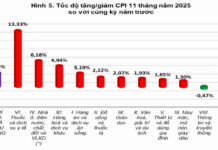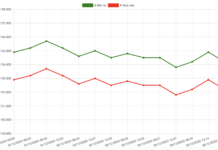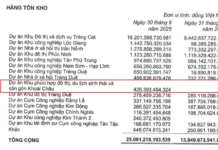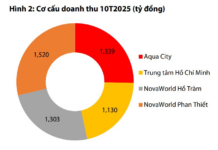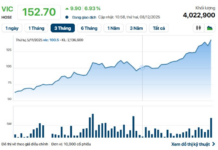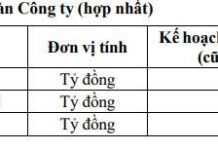Gold prices ended the week down for the first time in four weeks as the market bet on the US cutting interest rates after higher-than-expected US consumer price index (CPI) data was released on Tuesday and higher-than-expected producer prices (PPI) while retail sales were weak.
Spot gold ended the week at $2,159.99 per ounce, down 0.8% weekly, marking its first weekly decline since mid-February after hitting a record high of $2,194.99 in the previous week. The reference gold futures (currently the April contract) ended the week at $2,161.5 per ounce.
In the domestic market, gold prices fluctuated strongly in a downward trend along with the global prices. SJC gold pieces on Saturday morning (March 16) were priced at around ₫79.7-81.7 million per tael (buying – selling), slightly lower than ₫79.9-81.92 million per tael (buying – selling) a week earlier. There were times during the week when the price reached a record high of ₫80.5-82.5 million per tael (buying – selling), but then sharply reversed direction from Tuesday afternoon to Wednesday morning (March 12-13) when global gold prices plunged.
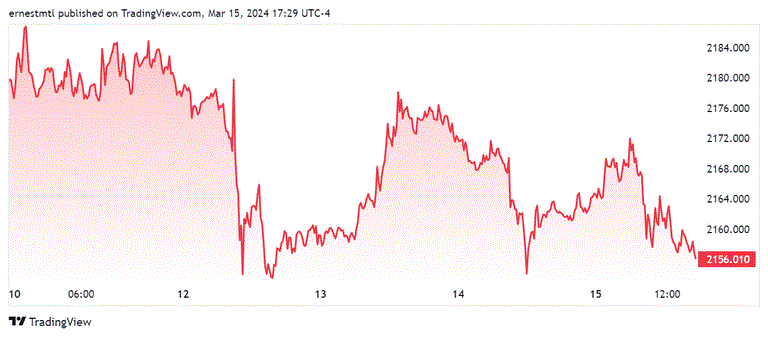
World gold prices last week.
“All recent gold price movements are due to expectations of interest rate cuts… if inflation starts to rise heavily again, it means US policymakers will have to maintain tight monetary policy for longer,” said Everett Millman, the head of market analysis at Gainesville Coins.
However, Millman added that “although gold doesn’t particularly like high interest rate environments, if the reason that interest rates are staying that high is because inflation is heating up… that naturally means people will go back into gold.”
Higher-than-expected inflation keeps pressure on the Fed to maintain high interest rates, putting pressure on gold. Precious metals do not generate interest rates and are also used as an inflation hedge.
Traders continue to bet that the Fed will cut interest rates in June, although the chances of a rate cut in June have fallen to 59%, from 72% before the CPI data was released.
The Dollar Index saw its strongest weekly gain since mid-January, making gold more expensive for foreign buyers.
The latest weekly survey by Kitco News shows that most of the optimistic sentiment among market experts last week has disappeared, while retail traders remain optimistic about gold’s prospects for the coming week.
Darin Newsom, Senior Market Analyst at Barchart.com, said: “I’ll keep a neutral bias on gold next week. “I think volatility can only occur after the Fed meeting, but the direction will depend on what Powell says.”
Bob Haberkorn, Senior Commodity Broker at RJO Futures, said that gold prices are very sensitive to inflation data as the Fed is trying to determine what interest rate trends might occur.
Haberkorn said: “I think the shock this week was just the reality that the Fed may not be ready to cut rates at this time.” “That’s what you’re seeing from the liquidation, the CPI and PPI were both hotter than expected. Last month was the same thing. And in terms of expectations, three months ago, we probably believed that the Fed would cut rates in March, but that has clearly been pushed back a few times.”
“How can they talk about cutting rates when CPI, PPI are showing that inflation remains persistent?”
Haberkorn speculated on the FOMC’s statement after high inflation numbers. “What will the Fed say next week? Will they indicate that they have to maintain their current policy? I mean, the possibility is that they might even have to say something about raising rates based on the data that we are seeing here.” “Some precious metal traders whom I have dealt with have mentioned buying gold and then selling it again, which means they are in a wait-and-see mode. I think precious metals, both gold and silver, seemed to want to go higher. But with stocks weighed down as they are now, I feel like there is no risk and I predict there will be some liquidation occurring in the near future.”
Haberkorn said he could see precious metals dropping a little next week, but the drop will be small and short-lived. “I think selling will be limited because at an all-time high gold price and with interest rates no matter how high, gold definitely demonstrates its safe-haven nature. There are concerns about U.S. government spending as well as concerns about the dollar, and people want to protect themselves, whether it be in the physical market or the futures market.”
He added: “Normally, with high interest rates like this, gold wouldn’t reach an all-time high.” “This just shows that there is a lot of trading going on for fear reasons. Gold might be sold off after the Fed announcement, but I don’t think the drop will be sustained, sellers will quickly buy back in.”
Next week, the focus of the market will be on information from major central banks, with interest rate decisions from the Bank of Japan and the Reserve Bank of Australia on Monday (March 18), the Federal Reserve on Wednesday (March 20), and the Bank of England and the Swiss National Bank on Thursday (March 21).
The markets will also pay attention to US housing starts and building permits data on Tuesday (March 19), as well as weekly jobless claims, Philly Fed manufacturing survey, flash PMI, and existing home sales on Thursday (March 21).
Reference: Kitco News








